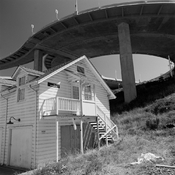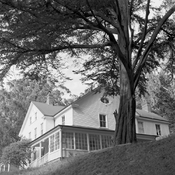No, Stephen. The curve shape distinction between FP4 and HP5 is there regardless of whether in sheet or roll version.
I totally disagree with Lachlan that these differences are inconsequential, or that all of them can be manipulated to resemble old Super XX. Nonsense. I have hundreds of prints which were highly successful because I recognized the real differences and when it particularly counted. Maybe he's simply not familiar with the implications of true high contrast settings which HP5 can't handle well. But I get that kind of pushback from any number of photographers who haven't spent their years like I have dealing with the extremes of sparkling glaciers adjacent to deep shade in high altitude light, or deep redwood forests with 12 stop extremes once the morning fog dissipates.
FP4, along with D100 and Acros, does somewhat better in that respect than HP5, but certainly nowhere near as well as TMax films or old "straight-line" films like Super-XX or Bergger 200, which all have a very short toe which rapidly launches off like a rocket onto the straight line section of the curve, allowing for significantly better deep shadow gradation.
Handling those kinds of very deep shade situations via overexposure just risks the upper end shouldering off and blowing out the highlights instead. Or the Zone System mantra tells you to flatten the whole contrast range with heavy handed compression or "minus" development, which inevitably smothers all the life and sparkle out of of delicate mid tonality too. It makes way more sense to go with a more suitable film choice to begin with, rather than pretending all films can be made to look the same.
I don't like referring to "Pushing" in this context because it misappropriates a term from color film lab development and makes its meaning ambiguous. At least the Zone System refers to shadow "placement" as an anchor point in reference to "expose for the shadows, develop for the highlights".
One problem with casual perusal of tiny abbreviated curves on tech sheets is that you can't as easily detect the toe distinctions anywhere near as well as making full scale densitometer plots on big sheets of translucent paper, and then seeing how well the respective results do or don't match over a light box.
Short story : Choose a shoe size which fits the foot comfortably, rather than trying to force the foot into a shoe too small to begin with. All of these films are capable of superb results, but not necessarily in every kind of lighting situation. FP4 is an excellent middle-of-the-road film in that respect; but it has its limitations. And people shouldn't confuse what it does well with what former Plus X was designed for - different animals indeed.













